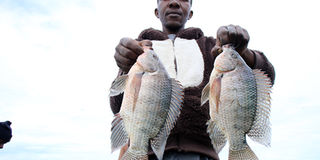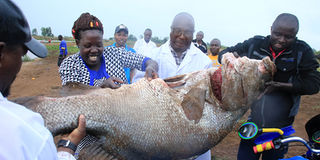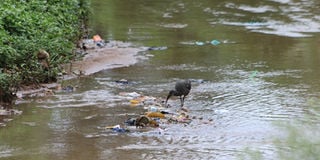Premium
Experts sound alarm on dwindling fish stock in Lake Victoria

A fisherman shows his tilapia catch in Asembo Bay. JEFF ANGOTE | NATION
The towns surrounding Lake Victoria have become popular among people looking to savour fish delicacies on the shores of the world’s second largest freshwater body.
Due to their proximity to the lake, the beaches of such major urban centres as Kisumu, Kendu Bay and Homa Bay have become some of the most sought-after travel destinations for both domestic and foreign tourists who want to enjoy the breeze while sampling the culinary delights from the region.
However, despite supporting the continent’s largest inland fishery, researchers are raising concern over the alarming decline of indigenous fish species in the lake.
While tilapia and Nile perch are currently the favoured catches due to their high demand, uncontrolled flow of toxic substances from industrial and agricultural sources into its waters spells doom for the lake.
According to Dr Christopher Aura, the assistant director for Freshwater Systems Research at the Kenya Marine and Fisheries Research Institute (KMFRI), the decline in commercial fishing due to the dwindling fish stocks is threatening the lake’s sustainability.
WATER HYACINTH
He said pollution, among other factors, has greatly contributed to the dwindling productivity of the lake, which in the past boasted one of the most diverse fish environments.
“The heavy pollution of the lake is made worse by the rapid growth of the invasive water hyacinth, which chokes aquatic life by deoxygenating the water and reducing nutrients for young fish in sheltered bays,” Dr Aura said.
Satellite images released by the agency in March last year showed that the area covered by the weed increased by over 1,400 hectares within four days.
Dr Aura underscored the need for enforcement agencies to ensure fishermen adhere to the recommended gear limits to prevent the harvesting of immature fish and destruction of the lake’s ecosystem.
“To sustain the fishery, we need a 36-44 per cent reduction in fish harvesting,” he said.

A Nile perch from Lake Victoria, near River Kuja. JEFF ANGOTE | NATION
The KMFRI assistant director noted that to harvest omena (silver cyprinid), fishers have shifted to the use of 10-milimetre mesh seine and lift nets.
“When the small seine nets are deployed without the aggregation lighting or during the day, they capture juveniles of the larger species,” Dr Aura said.
Mr Tom Guda, the chairman of Lake Victoria Beach Management Unit Network in East Africa, said the heavy pollution has negatively impacted the lake’s ecosystem, which was once rich in biodiversity.
“While growing up as a son of a fisherman who operated on the Kavirondo Gulf, my father used to catch a variety of fish, most of which have become extinct,” Mr Guda said.
He said the Tilapia species Oreochromis niloticus — locally known as ngege and preferred by many consumers — was introduced in the early 1950s from the Nile due to the near-extinction of the original Oreochromis variabilis.
“Locally known as mbiru, this type of fish was more nutritious and was usually prepared without cooking oil due to its high fat content,” he said.
IN 1950s
The Nile perch was also introduced from lakes Turkana and Albert in the 1950s.
Compared to five years ago, another popular delicacy known as kamongo in Dholuo has also become rare.
Traditionally, the fish was sun-dried before it was cooked using milk to make a sumptuous meal with thick soup.
“This kind of fish was preferred by elders and was caught by experienced and elderly fishermen,” Mr Auda said.
Seu (bagras docmac) was an important meal for fishermen and boat owners who preferred carrying the catch home or giving it to their valued friends or relatives instead of selling it.
“This was prepared in traditional pots and was usually accompanied by some local brew. It was popular with elders, particularly during special cultural celebrations,” Mr Guda said.

A polluted Nakivubo River in Uganda. JEFF ANGOTE | NATION
Other popular fish varieties that were abundant in Lake Victoria decades ago but are now almost extinct are fulu (haplochromis nubilus), okoko (synodontis), mumi (clarias gariepinus), ningu (gregorislabeo) and sire (bagrus docmac).
Mr Guda added that the snouted suma (mormmyrus kanume), Okunga (longtail spinyeel), adel (barbus yongei) and obu have disappeared from the lake.
“Obu, which belongs to the same family as ngege, was loved for its large chunks of meat and was very delicious,” he said.
Unless something is urgently done by relevant government agencies to curb the runaway pollution, Mr Guda predicted a gloomy future for the thousands of people who depend on Lake Victoria for their livelihood.
The National Environment Management Authority has since cautioned against increasing levels of contamination by companies that discharge raw industrial waste into River Kibos, which drains into Lake Victoria.


